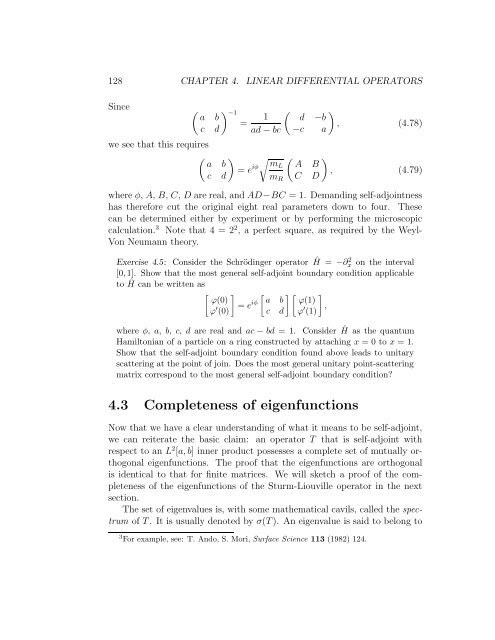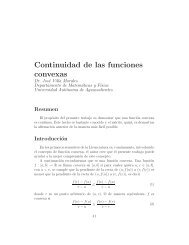Chapter 4 Linear Differential Operators
Chapter 4 Linear Differential Operators
Chapter 4 Linear Differential Operators
You also want an ePaper? Increase the reach of your titles
YUMPU automatically turns print PDFs into web optimized ePapers that Google loves.
128 CHAPTER 4. LINEAR DIFFERENTIAL OPERATORS<br />
Since −1 a b<br />
=<br />
c d<br />
<br />
1 d −b<br />
, (4.78)<br />
ad − bc −c a<br />
we see that this requires<br />
<br />
a<br />
c<br />
<br />
b<br />
= e<br />
d<br />
iφ<br />
<br />
mL A<br />
mR C<br />
<br />
B<br />
,<br />
D<br />
(4.79)<br />
where φ, A, B, C, D are real, and AD−BC = 1. Demanding self-adjointness<br />
has therefore cut the original eight real parameters down to four. These<br />
can be determined either by experiment or by performing the microscopic<br />
calculation. 3 Note that 4 = 2 2 , a perfect square, as required by the Weyl-<br />
Von Neumann theory.<br />
Exercise 4.5: Consider the Schrödinger operator ˆ H = −∂ 2 x on the interval<br />
[0, 1]. Show that the most general self-adjoint boundary condition applicable<br />
to ˆ H can be written as<br />
<br />
ϕ(0)<br />
ϕ ′ <br />
= e<br />
(0)<br />
iφ<br />
<br />
a b ϕ(1)<br />
c d ϕ ′ <br />
,<br />
(1)<br />
where φ, a, b, c, d are real and ac − bd = 1. Consider ˆ H as the quantum<br />
Hamiltonian of a particle on a ring constructed by attaching x = 0 to x = 1.<br />
Show that the self-adjoint boundary condition found above leads to unitary<br />
scattering at the point of join. Does the most general unitary point-scattering<br />
matrix correspond to the most general self-adjoint boundary condition?<br />
4.3 Completeness of eigenfunctions<br />
Now that we have a clear understanding of what it means to be self-adjoint,<br />
we can reiterate the basic claim: an operator T that is self-adjoint with<br />
respect to an L 2 [a, b] inner product possesses a complete set of mutually orthogonal<br />
eigenfunctions. The proof that the eigenfunctions are orthogonal<br />
is identical to that for finite matrices. We will sketch a proof of the completeness<br />
of the eigenfunctions of the Sturm-Liouville operator in the next<br />
section.<br />
The set of eigenvalues is, with some mathematical cavils, called the spectrum<br />
of T . It is usually denoted by σ(T ). An eigenvalue is said to belong to<br />
3 For example, see: T. Ando, S. Mori, Surface Science 113 (1982) 124.




